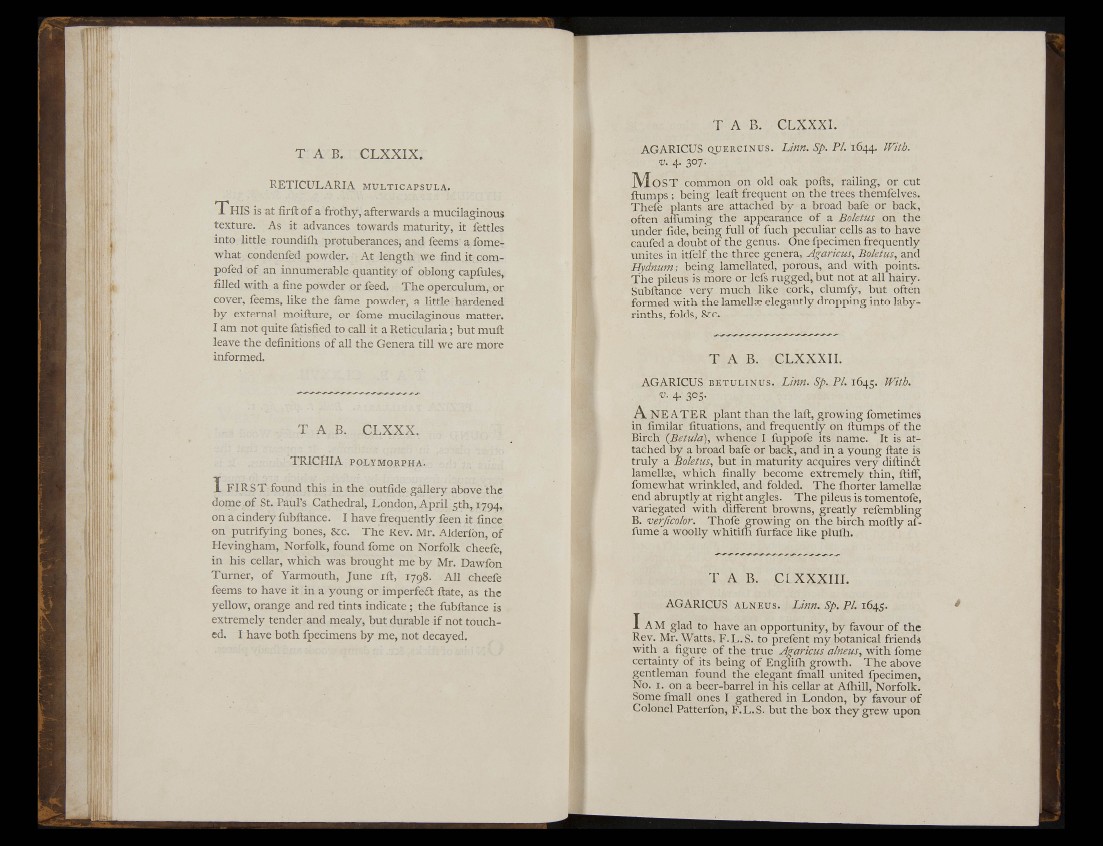
• .
••Mi
T A B . CLXXIX.
RETICULARIA MULTICAPSULA.
T H I S is at firft of a frothy, afterwards a mucilaginous
texture. As it advances towai'ds maturity, it fettles
into little roundiili protuberances, and feems a fomewhat
condenfed powder. At length we find it corapofed
of an innumerable quantity of oblong capfules,
filled with a fine powder or feed. The operculum, or
cover, feems, like the fame powder, a little hardened
by external moiilure, or fome mucilaginous matter.
I am not quite fatisfied to call it a Reticularia; but muil
leave the definitions of all the Genera till we are more
informed.
T A B . CLXXX.
TRICHIA POLYMORPHA.
I FIRST found this in the outfide gallery above the
dome of St. Paul's Cathedral, London, April 5th, 1794,
on a cindery fubftance. I have frequently feen it fince
on putrifying bones. See. The Rev. Mr. Alderfon, of
Hevingham, Norfolk, found fome on Norfolk cheefe,
in his cellar, which was brought me by Mr. Dawfon
Turner, of Yarmouth, June ift, 1798. All cheefe
feems to have it in a young or imperfecSl ilate, as the
yellow, orange and red tints indicate; the fubftance is
extremely tender and mealy, but durable if not touched.
I have both fpecimens by me, not decayed.
T A B. CLXXXl.
AGARICUS QUERCINUS. Linn. Sp. PL 1644. mtb.
V. 4. 307-
. M O S T common on old oak pofts, raihng, or cut
flumps ; being leaft frequent on the trees themfelves.
Thefe plants are attached by a broad bafe or back,
often affuming the appearance of a Boletus on the
under fide, being full of fuch peculiar cells as to have
caufed a doubt of the genus. One fpecimen frequently
unites in itfelf the three genera, Agaricus, Boletus, and
Hydnum; being lamellated, porous, and with points.
The pileus is more or lefs rugged, but not at all hairy.
Subftance very much like cork, clumfy, but often
formed with the lamellae elegantly dropping into labyrinths,
folds, &:c.
T A B. CLXXXII.
AGARICUS BETULINUS. Linn. Sp. PL 1645. With.
V. 4. 305.
A NEATER, plant than the laft, growing fometimes
in fimilar fituations, and frequently on ftumps of the
Birch {Betula\ whence I fuppofe its name. It is attached
by a broad bafe or back, and in a young ftate is
truly a Boletus, but in maturity acquires very diftincSl
lamelloe, which finally become extremely thin, ftifF,
fomewhat wrinkled, and folded. The iliorter lamellae
end abruptly at rigl^ angles. The pileus is tomentofe,
woolly plufli.
T A B . CLXXXIII.
AGARICUS ALNEUS. Linn. Sp. PL 1645.
I A M glad to have an opportunity, by favour of the
Rev. Mr. Watts, F.L.S. to prefent my botanical friends
with a figure of the true Agaricus alneus, with fome
certainty of its being of Engliili growth. The above
gentleman found the elegant fmall united fpecimen,
No. I. on a beer-barrel in his cellar at Aihill, Norfolk.
Some fmall ones I gathered in London, by favour of
Colonel Patterfon, F.L.S. but the box they grew upon